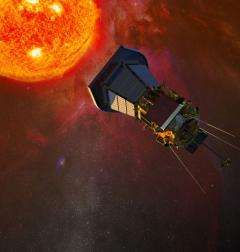The Solar Probe Plus spacecraft with solar panels folded into the shadows of its protective shield, gathers data on its approach to the Sun. Credit: JHU/APL
NASA has begun development of a mission to visit and study the sun closer than ever before. The unprecedented project, named Solar Probe Plus, is slated to launch no later than 2018.
The small car-sized spacecraft will plunge directly into the sun's atmosphere approximately four million miles from our star's surface. It will explore a region no other spacecraft ever has encountered. NASA has selected five science investigations that will unlock the sun's biggest mysteries.
"The experiments selected for Solar Probe Plus are specifically designed to solve two key questions of solar physics -- why is the sun's outer atmosphere so much hotter than the sun's visible surface and what propels the solar wind that affects Earth and our solar system? " said Dick Fisher, director of NASA's Heliophysics Division in Washington. "We've been struggling with these questions for decades and this mission should finally provide those answers."
As the spacecraft approaches the sun, its revolutionary carbon-composite heat shield must withstand temperatures exceeding 2550 degrees Fahrenheit and blasts of intense radiation. The spacecraft will have an up close and personal view of the sun enabling scientists to better understand, characterize and forecast the radiation environment for future space explorers.
NASA invited researchers in 2009 to submit science proposals. Thirteen were reviewed by a panel of NASA and outside scientists. The total dollar amount for the five selected investigations is approximately $180 million for preliminary analysis, design, development and tests.
Animation of the future Heliophysics mission Solar Probe Plus (SPP). Starts with the probe, solar shield forward, heading directly toward the viewer, retracting its solar panels as it passes by, showing the spacecraft instrumentation behind the shield, and ending with the SPP craft pointing towards the Sun, in anticipation of its plunge into the Sun.
The selected proposals are:
-- Solar Wind Electrons Alphas and Protons Investigation: principal investigator, Justin C. Kasper, Smithsonian Astrophysical Observatory in Cambridge, Mass. This investigation will specifically count the most abundant particles in the solar wind -- electrons, protons and helium ions -- and measure their properties. The investigation also is designed to catch some of the particles in a special cup for direct analysis.
-- Wide-field Imager: principal investigator, Russell Howard, Naval Research Laboratory in Washington. This telescope will make 3-D images of the sun's corona, or atmosphere. The experiment actually will see the solar wind and provide 3-D images of clouds and shocks as they approach and pass the spacecraft. This investigation complements instruments on the spacecraft providing direct measurements by imaging the plasma the other instruments sample.
-- Fields Experiment: principal investigator, Stuart Bale, University of California Space Sciences Laboratory in Berkeley, Calif. This investigation will make direct measurements of electric and magnetic fields, radio emissions, and shock waves that course through the sun's atmospheric plasma. The experiment also serves as a giant dust detector, registering voltage signatures when specks of space dust hit the spacecraft's antenna.
-- Integrated Science Investigation of the Sun: principal investigator, David McComas of the Southwest Research Institute in San Antonio. This investigation consists of two instruments that will take an inventory of elements in the sun's atmosphere using a mass spectrometer to weigh and sort ions in the vicinity of the spacecraft.
-- Heliospheric Origins with Solar Probe Plus: principal investigator, Marco Velli of NASA's Jet Propulsion Laboratory in Pasadena, Calif. Velli is the mission's observatory scientist, responsible for serving as a senior scientist on the science working group. He will provide an independent assessment of scientific performance and act as a community advocate for the mission.
"This project allows humanity's ingenuity to go where no spacecraft has ever gone before," said Lika Guhathakurta, Solar Probe Plus program scientist at NASA Headquarters, in Washington. "For the very first time, we'll be able to touch, taste and smell our sun."
More information: solarprobe.gsfc.nasa.gov/
Provided by JPL/NASA






















